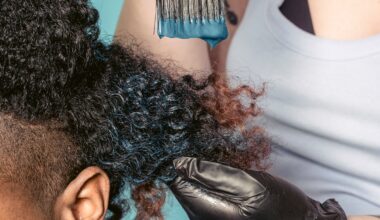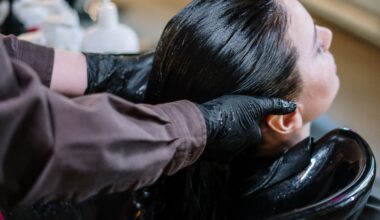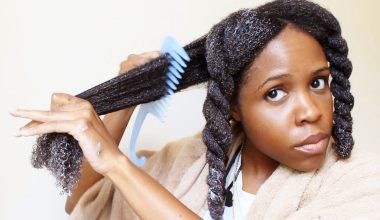Introduction
Everyone wants soft, smooth, and manageable hair. One of the vital products that promises to deliver these results is hair conditioner. But a common question that lingers in many minds is: “How much hair conditioner should I use?” The answer, surprisingly, is not as straightforward as one might think.
While most of us have been conditioned (pun intended) to believe that “more is better”, when it comes to hair care products, this isn’t always the case. Too much conditioner can weigh down your hair, making it look flat and greasy. On the other hand, using too little might not provide the desired nourishment, leaving hair tangled and prone to breakage.
This guide aims to demystify the process of conditioning, giving you a clear roadmap on using the right amount of conditioner for your specific hair type and needs. Whether you have long tresses, curly locks, or a short bob, you’ll discover the secrets to achieving the perfect balance. So, let’s dive in and get your hair game on point!
Key Takeaways
- Understanding the importance of the right conditioner quantity.
- Factors that influence how much conditioner you should use.
- Common pitfalls to avoid in the conditioning process.
- The cost spectrum of hair conditioners and how to make an informed choice.
- Recommendations on frequency and best practices.
How Much Hair Conditioner Should You Use?
Every strand of hair on our heads is unique and, as a result, everyone’s hair requires individual care. When it comes to conditioner, there is no universal answer that fits all. However, there are some general guidelines you can follow:
- Hair Length:
- Short Hair: If you have a pixie cut or short bob, a dime-sized amount of conditioner is usually sufficient.
- Medium Length Hair: For hair that falls to the shoulders or a bit below, a nickel to a quarter-sized amount should do the trick.
- Long Hair: If your hair extends down your back, you might need between a quarter and a half-dollar sized amount, depending on its thickness.
- Hair Type:
- Fine Hair: Fine hair can easily be weighed down by products. So, a lesser quantity that focuses mainly on the ends is ideal.
- Thick or Curly Hair: These hair types tend to be drier and can handle (and often need) more conditioner. Focus on the mid-lengths and ends, avoiding the scalp.
- Hair Needs:
- Colored Hair: Dyed or treated hair can be drier and more fragile. It might require a tad more conditioner than usual to restore its moisture balance.
- Oily Hair: If your hair tends to get oily quickly, you might want to use a lighter conditioner and focus on the ends only.
Remember, these are just guidelines. The real test is your hair’s feel and look after conditioning. If it feels heavy or greasy, you’ve likely used too much. If it feels tangled or rough, you might need a bit more next time.
Avoiding Common Pitfalls: Using Hair Conditioner Effectively
When conditioning, it’s not just about how much product you use but also how you use it. Here are some common mistakes people make and how to avoid them:
- Applying Conditioner to the Scalp: Unless you have very dry hair, applying conditioner directly to the scalp can cause it to become oily faster. Focus on mid-lengths and ends.
- Not Rinsing Thoroughly: Any residue can make hair look dull and feel heavy. Ensure you rinse your hair thoroughly until the water runs clear.
- Using Conditioner Before Shampoo: For most people, conditioner should be used after shampooing. There are co-washing products designed to be used alone, but standard conditioners work best after a shampoo.
Understanding the right quantity and method of applying conditioner can transform your hair from dull and lifeless to vibrant and lively. Adjustments based on individual needs are essential. After all, the journey to perfect hair is all about trial and error until you find what works best for you.
The Cost of Hair Conditioner: What to Expect
When browsing hair care products, you’ll notice a broad range of prices for conditioners. The cost often depends on several factors:
- Brand and Quality:
- High-end Brands: Products from luxury hair care brands, often used in professional salons, tend to have a steeper price due to the quality of ingredients and the brand’s reputation.
- Drugstore Brands: More accessible and budget-friendly, these brands provide a variety of options suitable for different hair types and needs.
- Ingredients:
- Natural and Organic Ingredients: Conditioners made with organic or natural ingredients, free from harsh chemicals, might cost more but are preferred by those seeking a more holistic approach to hair care.
- Special Formulations: Products designed for specific issues, like color protection or damage repair, might also have a higher price point due to their specialized ingredients.
- Size and Packaging:
- Often, buying in bulk or larger sizes can be more cost-effective in the long run. Eco-friendly packaging or innovative applicator designs might also influence the price.
How Often Should You Use Hair Conditioner?
The frequency of conditioning largely depends on your hair’s type and health:
- Every Wash: For those with dry, curly, or coarse hair, conditioning after every shampoo can help maintain moisture balance.
- Alternate Days: People with normal hair might find that conditioning every other day is sufficient.
- Once a Week: If you have oily hair, a deep conditioning once a week might be all you need to prevent over-moisturizing and weighing it down.
Remember, daily washing and conditioning can strip hair of its natural oils. It’s crucial to find a balance that maintains hair health without overdoing it.
Is It Possible to Use Too Much Hair Conditioner?
Absolutely! Over-conditioning, or “conditioner overload”, can have its downsides:
- Weighed Down Hair: Using too much conditioner can make hair feel heavy, reducing its natural volume and bounce.
- Residue Buildup: Excess product can build up over time, leading to a dull appearance and potential scalp issues.
- Oiliness: Over-conditioning can lead to increased oil production, making hair greasy faster.
The key is to strike a balance. Start with the recommended amount and adjust based on your hair’s response.
Incorporating the right conditioning routine is crucial for maintaining hair health. With knowledge on how much to use and how often, you’re better equipped to give your hair the care it deserves.
Measuring Hair Conditioner: ML per Wash
When we discuss the amount of conditioner to use, quantifying it in milliliters (ML) can offer a clear guideline. Here’s a rough guide:
- Short Hair: If your hair is short and above the neck, you might only need a coin-sized amount, roughly 2-3 ML.
- Medium-Length Hair: For hair that reaches to the shoulders, a slightly larger dollop (about 5-7 ML) should suffice.
- Long Hair: If your hair goes beyond your shoulders, you’ll likely require more conditioner to cover the entire length, around 10 ML or more depending on thickness.
However, these are general guidelines, and your hair’s thickness, porosity, and overall condition can influence the amount needed.
Hair Conditioner Pricing in Nigeria: What to Know
The Nigerian hair care market boasts a rich array of products. When it comes to conditioner prices:
- Local Brands: Many local brands incorporate indigenous ingredients known for promoting hair health. These can be quite affordable, ranging from NGN 500 to NGN 2000.
- International Brands: Imported conditioners, especially from luxury hair care lines, can be pricier, often ranging from NGN 2000 to NGN 10,000 and above.
- Buying Considerations: When purchasing in Nigeria, it’s essential to consider:
- Quality vs. Quantity: A larger bottle might seem like a better deal, but it’s the product’s effectiveness that truly matters.
- Ingredient List: Look for conditioners without harmful chemicals and with nourishing ingredients.
Conclusion
Navigating the world of hair conditioning can be overwhelming, given the myriad of products and advice available. However, with a keen understanding of your hair type, its specific needs, and armed with knowledge about quantities and frequencies, you can maximize the benefits of your conditioner. Always remember that less can often be more, and it’s about finding what works best for your unique hair.
Additional Resources
For those eager to delve deeper into hair care:
- Books:
- “The Science of Black Hair” by Audrey Davis-Sivasothy offers insights into the unique properties and needs of African hair types.
- “The Hair Bible: A Complete Guide to Health and Care” by Philip Kingsley provides a comprehensive look at hair care from a trichological perspective.
- Websites:
- HairCareJourney offers tips, tricks, and product recommendations for different hair types.
- NaturallyCurly is a community-driven site dedicated to those with curly hair but has a wealth of information for all hair types.
By educating yourself further, you’re taking a proactive step toward healthier, shinier, and more luscious locks.






